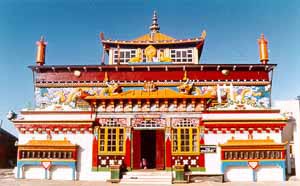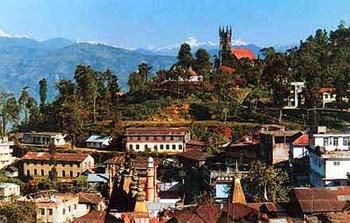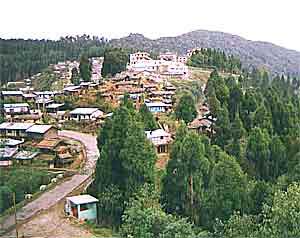Apr 13, 2025
Apr 13, 2025
Every year in summer the Viceroys of India moved to the north of West Bengal, the mountains of the Eastern Himalayas often so very reminiscent of home in England. The district of Darjeeling extending over 3,005 km is bounded on the north and west by Nepal and Sikkim, on the south by Purnea and West Dinajpur districts and on the east by Bangladesh and Jalpaiguri. Darjeeling lies in the mountains of the lower Himalayas and a stretch of territory lying along the base of the hills known as the terai. Darjeeling is a three hour drive from New Jalpaiguri after an overnight journey from Kolkata. Gaining altitude and negotiating the ghat road through the picturesque Mahananda Wildlife Sanctuary on one side and the river Teesta on the other we discover lush tea gardens ' a verdant paradise. Acquired by the East India Company from the Raja of Sikkim in 1835, the district of Darjeeling, the queen of hill stations, at an altitude of 7432 feet, gets its name from Dorje Ling ' the place of theDorje, the mystic thunderbolt of the Lamaist religion. A Buddhist monastery on the top of the Observatory Hill was destroyed in the nineteenth century. Now a temple dedicated to Mahakal, a manifestation of Shiva, attracts crowds of devotees. The Bhutia basti down the hill is home to the rebuilt monastery - Bhutia monastery. Darjeeling lies on a long spur projecting northwards from Ghum, the Senchal Ridge. The mall situated just below the Observatory Hill is home to some of the oldest hotels and is crowded with tourists throughout the day, riding horses or just soaking in the sun. Tourists mingle with the locals savouring some of the best local scenes while in the background the Kanchenjunga looms majestically. During weekends the police band provides a brief musical interlude in the evening. A little way down from the Mall is Step Aside, where Deshbandhu Chittaranjan Das breathed his last. The Mall leads to the Chaurasta, a square with a bandstand, a bookshop selling old books on India and Tibet, and shops selling curios. Nearby is the Planters' Club which becomes lively on Sundays when planters from all over the area meet for lunch. About a mile and a half from the Mall is Birch Hill (now Jawahar Hill), on the slopes of which are the Padmaja Naidu Zoological park and the Tenzing Norgay Mountaineering Institute (erstwhile Himalayan Mountaineering Institute). The zoo is home to the Himalayan Bear, panda, panther, leopard, the Bengal barking deer and the Siberian Tiger. On clear mornings from Tiger Hill(8, 515 feet), 11 km from Darjeeling, the rays of the rising sun give a grandstand view of the magnificent snow-capped Himalayan peaks ' the Kanchenjunga (28,146 feet) in the centre flanked by the tent-like Kabru (24,015 feet) and Kumbhakarna or Janu (25,300 feet) on the west, the sharp peaks of Pandim (22,300 feet) and Narsingh (18,145 feet) on the east, to the north east Simvo (22,369 feet), and in the northwest the three sisters of the Singalila range ' Mt. Everest, Makalu and Lhotse. Toy Train, Darjeeling On the way back from Tiger Hill lies Ghum, home to the Yiga Cholang yellow hat monastery and the famous Batasia loop. Built in 1850 the monastery houses a 15 feet Buddha. Possibly one of the most interesting sights in Darjeeling is that of the little train chugging along the winding tracks that move up and down, sometimes moving parallel to the road and sometimes crisscrossing the road. The Batasia loop is unique to Darjeeling ' the railway takes a sharp U-turn and provides a delightful view of the toy train as it winds its way round the loop. Overlooking the Batasia loop is a war memorial honoring the brave Gorkha soldiers. Yiga Cholang Monastery, Ghum Mirik (5,000 feet), 49 km from Darjeeling, is located on the top of the Singalila Mountains. Its main attraction is Sumendu Lake set amidst forests of Japanese cedar (Cryptomeria japonica). The high mountains west of Mirik are home to orange, cinnamon and pine plantations. Mirik bazaar situated a little distance away from the lake is one of the biggest orange marts in the district. 51 km east of Darjeeling is Kalimpong (4100 feet), the former headquarters of the Governor of Bhutan. Lying in the hills of Deolo and Durbindra at the foot of the mighty Himalayas, Kalimpong offers a great launch pad for the wonders of the eco-tourism centres of Lava and Loleygaon. An important transit point on the trade route to Tibet and Sikkim, Kalimpong was under Sikkim rulers till 1706 later becoming the headquarters of the Bhutanese Governor. The name Kalimpong is derived from Bhutanese kalim 'minister' and pong 'a fort'. In 1780, the Gorkhas captured a part of this town and in the 19th century it fell to the British. The journey from Darjeeling to Kalimpong through the rich forests and undulating tea gardens affords some of the finest views of the valley, which is the confluence of the Rangeet and Teesta rivers. According to Lepcha legend the two rivers, Rangeet and Teesta are lovers who fled the mountains to hide their love and were united at Pashoke, the confluence of the two rivers. The icy cold waters of the Teesta and Rangeet with their rapids and spectacular scenery offer the more adventurous the opportunity of white water rafting. Kalimpong Lava (7,200 feet), the most picturesque place of this region, is 32 km from Kalimpong. Lava monastery with its fluttering prayer flags affords a breathtaking view of the place. Strains of prayer emanate from this monastery invigorating the surroundings and adding a sense of surrealism to an already enchanting place. From this monastery can be seen Lava in its entirety, the small houses on the slopes, the verdant mountains, conifer plantations, the clouds caressing the morning sun- a sight marred only by the smoke spewing from the passing cars and jeeps. On a clear morning one can see the Himalayan ranges of Kanchenjunga, Kabru, Sinolchu, and Pandim from Lava. Another significant feature of Lava is the view it offers of the Chola range that forms part of the border between India and Tibet. The range has two famous passes ' Nathula and Jelepla. The former was the point at which the Indian and Chinese army faced each other and the latter was used as the gateway to Lhasa in the old trade route. Francis Younghusband used the Jelepla in 1903 to go to Tibet and this pass is also known as the Younghusband track. A drive to Chodoferi leads one to Neora valley that is home to the elusive red panda, the clouded leopard, the marble cat and the Himalayan black bear. This valley and its dense forest form a border with Sikkim and Bhutan and extend into the Dooars region of North Bengal. The original inhabitants of the place live in the village of Kafer and do not seem disturbed by the constant influx of tourists. Instead they have taken it so well in their stride converting most of their homes into hotels and the chance of savoring local delicacies. Walking here is a pleasure since it gives the opportunity of feeling the calmness of nature, its vibrancy and variety. When dusk falls, the entire place is enveloped in silence accentuated by the cold. As darkness engulfs the place the distant mountains are lit up, it seems, by a thousand lamps adding magic to the place. 

 Situated next to Darjeeling railway station and hidden among houses is the Dhirdham Temple dedicated to Pashupatinath. The temple built in 1938 by Maharaja Shamshere Jung Bahadur Rana, is a replica of the famous Pashupatinath temple in Kathmandu. The 45 minute ride on the 8 km long Passenger Ropeway, over rolling tea gardens, connects Darjeeling to Singla bazaar.
Situated next to Darjeeling railway station and hidden among houses is the Dhirdham Temple dedicated to Pashupatinath. The temple built in 1938 by Maharaja Shamshere Jung Bahadur Rana, is a replica of the famous Pashupatinath temple in Kathmandu. The 45 minute ride on the 8 km long Passenger Ropeway, over rolling tea gardens, connects Darjeeling to Singla bazaar. The Raja Dorje market of the town is only 3930 feet and is flanked on the south by the Durbindra ( 4, 500 feet) and on the north east by the Deolo hill (5, 564 feet). Tharpa Choling Monastery at Tirpai, the larger of the two Yellow Hat Buddhist monasteries, houses a library of Tibetan manuscripts. Zang Dnog Phelri Monastery on Durbindra was built in 1937. Chants accompanied by gongs resound throughout lending an ethereal feel to the place along with Buddhist flags fluttering and the whirl of the prayer wheels. Kalimpong is home to Dr. Graham's Homes built in 1900 by Rev. Dr. J. A. Graham, Guild Missionary of the Church of Scotland. Situated on an estate of 611 acres, it is home to over 700 students.
The Raja Dorje market of the town is only 3930 feet and is flanked on the south by the Durbindra ( 4, 500 feet) and on the north east by the Deolo hill (5, 564 feet). Tharpa Choling Monastery at Tirpai, the larger of the two Yellow Hat Buddhist monasteries, houses a library of Tibetan manuscripts. Zang Dnog Phelri Monastery on Durbindra was built in 1937. Chants accompanied by gongs resound throughout lending an ethereal feel to the place along with Buddhist flags fluttering and the whirl of the prayer wheels. Kalimpong is home to Dr. Graham's Homes built in 1900 by Rev. Dr. J. A. Graham, Guild Missionary of the Church of Scotland. Situated on an estate of 611 acres, it is home to over 700 students. Loleygaon or Kafer (5, 500 feet) as the locals call it, is 22 km from Lava on undulating slopes amidst pine and cypress trees. Sunrise at Jhandidara, 175 m from Loleygaon is breathtaking. The rays of the sun illuminate the Kanchenjunga giving it initially a beautiful pink and then a bright golden hue. One can even catch a glimpse of the mighty Everest. On clear mornings the snow-capped ranges of Kabru, Sinolchu, and Pandim along with the mountain passes of Nathula and Jelepla can be seen from this place as also the towns of Kalimpong right in front and Darjeeling on a mountain in the far distance. The road to Jhandidara takes one through the dense forest and the bitter cold adds to the romance of the place. Loleygaon Heritage Forest, just a few minutes walk from the bus stop and the village of Kafer offer untold possibilities for the tourist. There is a huge wooden suspension bridge that takes one across almost to the middle of the forest. The thick vegetation filters the sun's rays through the forest canopy ' a lyrical dapple on the dark forest floor, infested with blood-sucking leeches.
Loleygaon or Kafer (5, 500 feet) as the locals call it, is 22 km from Lava on undulating slopes amidst pine and cypress trees. Sunrise at Jhandidara, 175 m from Loleygaon is breathtaking. The rays of the sun illuminate the Kanchenjunga giving it initially a beautiful pink and then a bright golden hue. One can even catch a glimpse of the mighty Everest. On clear mornings the snow-capped ranges of Kabru, Sinolchu, and Pandim along with the mountain passes of Nathula and Jelepla can be seen from this place as also the towns of Kalimpong right in front and Darjeeling on a mountain in the far distance. The road to Jhandidara takes one through the dense forest and the bitter cold adds to the romance of the place. Loleygaon Heritage Forest, just a few minutes walk from the bus stop and the village of Kafer offer untold possibilities for the tourist. There is a huge wooden suspension bridge that takes one across almost to the middle of the forest. The thick vegetation filters the sun's rays through the forest canopy ' a lyrical dapple on the dark forest floor, infested with blood-sucking leeches.
17-Feb-2007
More by : Dr. Nishi Pulugurtha